The Rise and Fall of the Ford Edsel
In trying to close the gap between itself and GM, Ford marketed the Edsel as the car of the future. But the Edsel didn't have a future -- just a disastrous two years in which the Ford Motor Company lost 400 million dollars. Read all about it here.


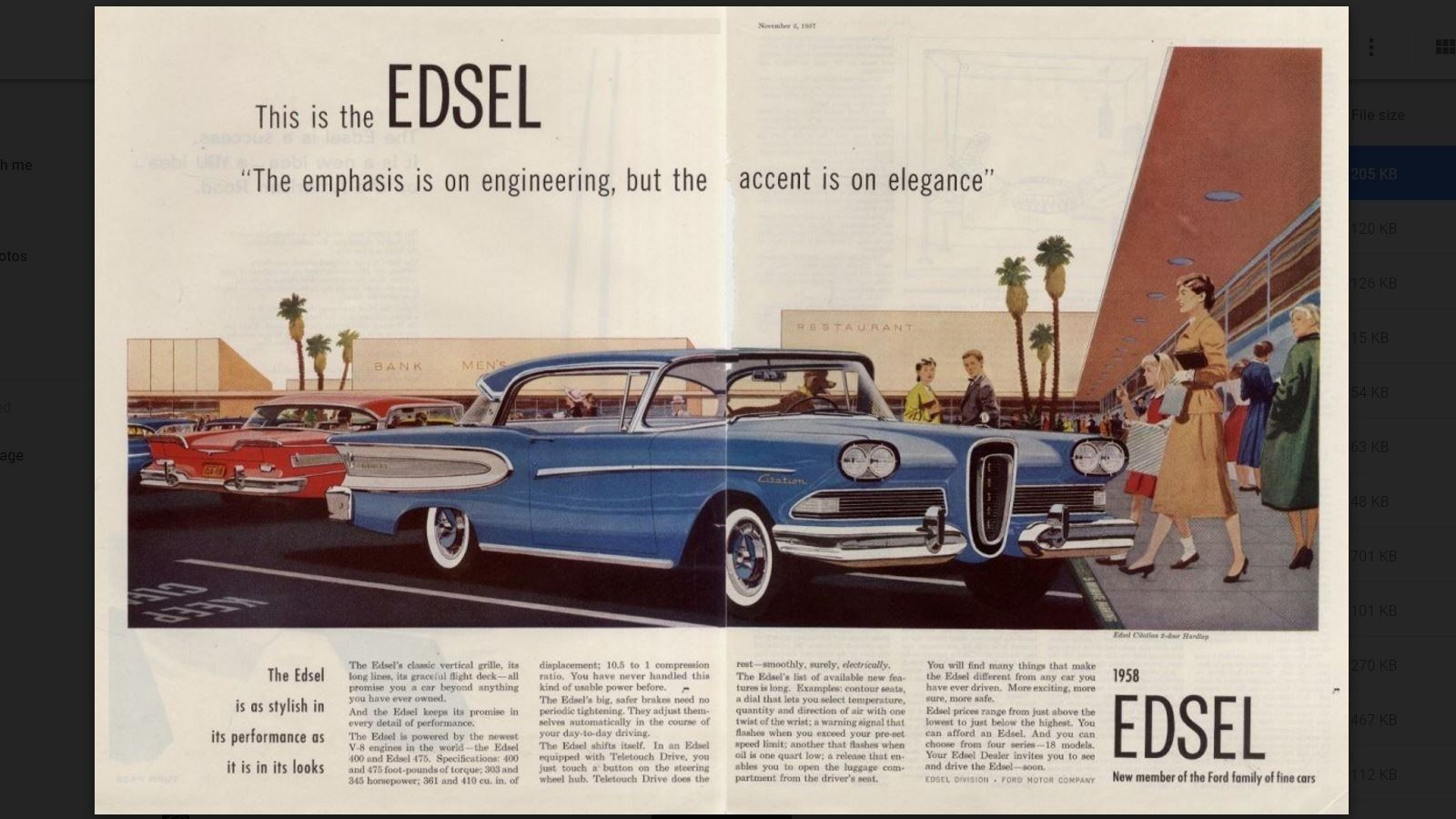


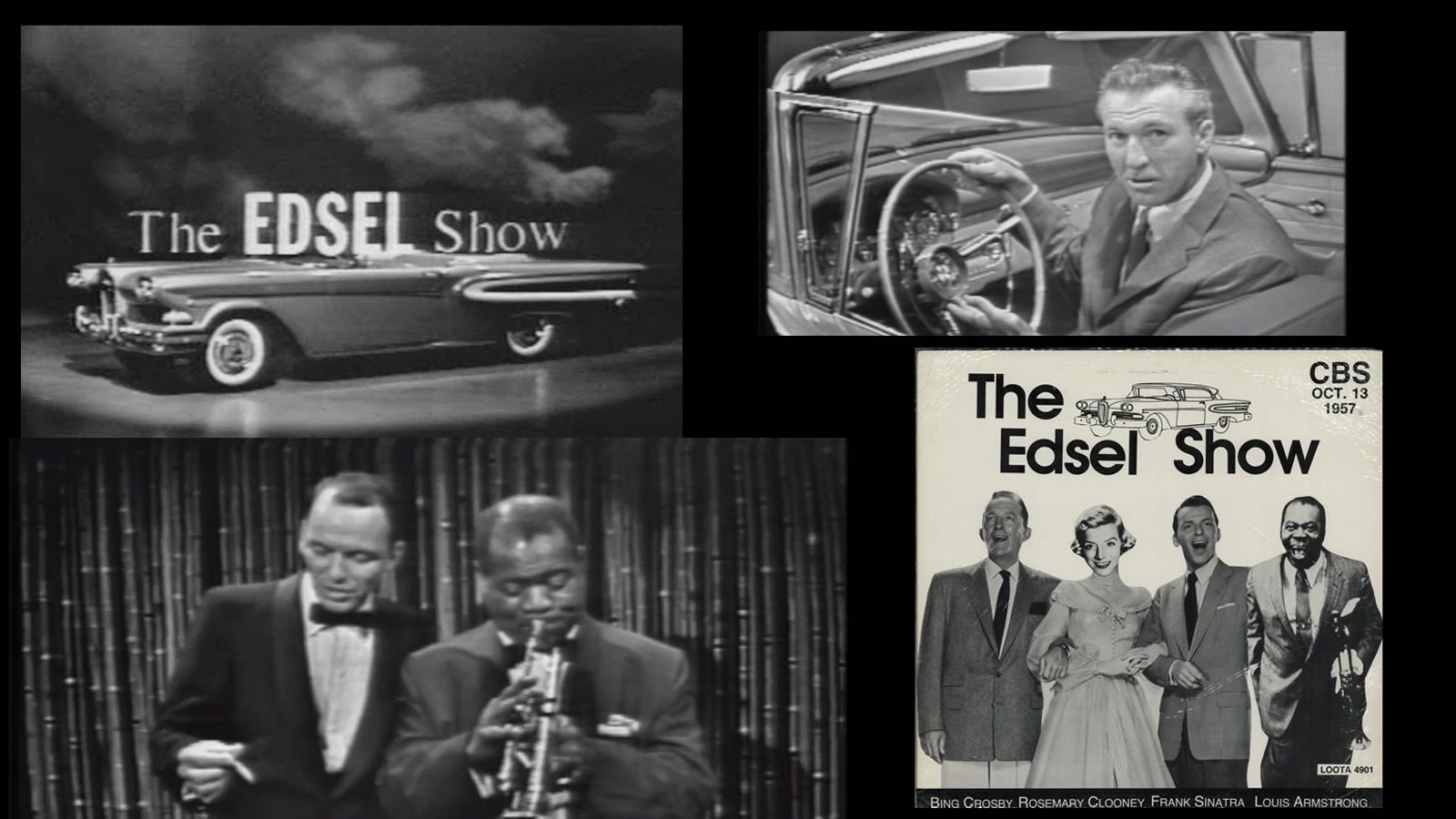
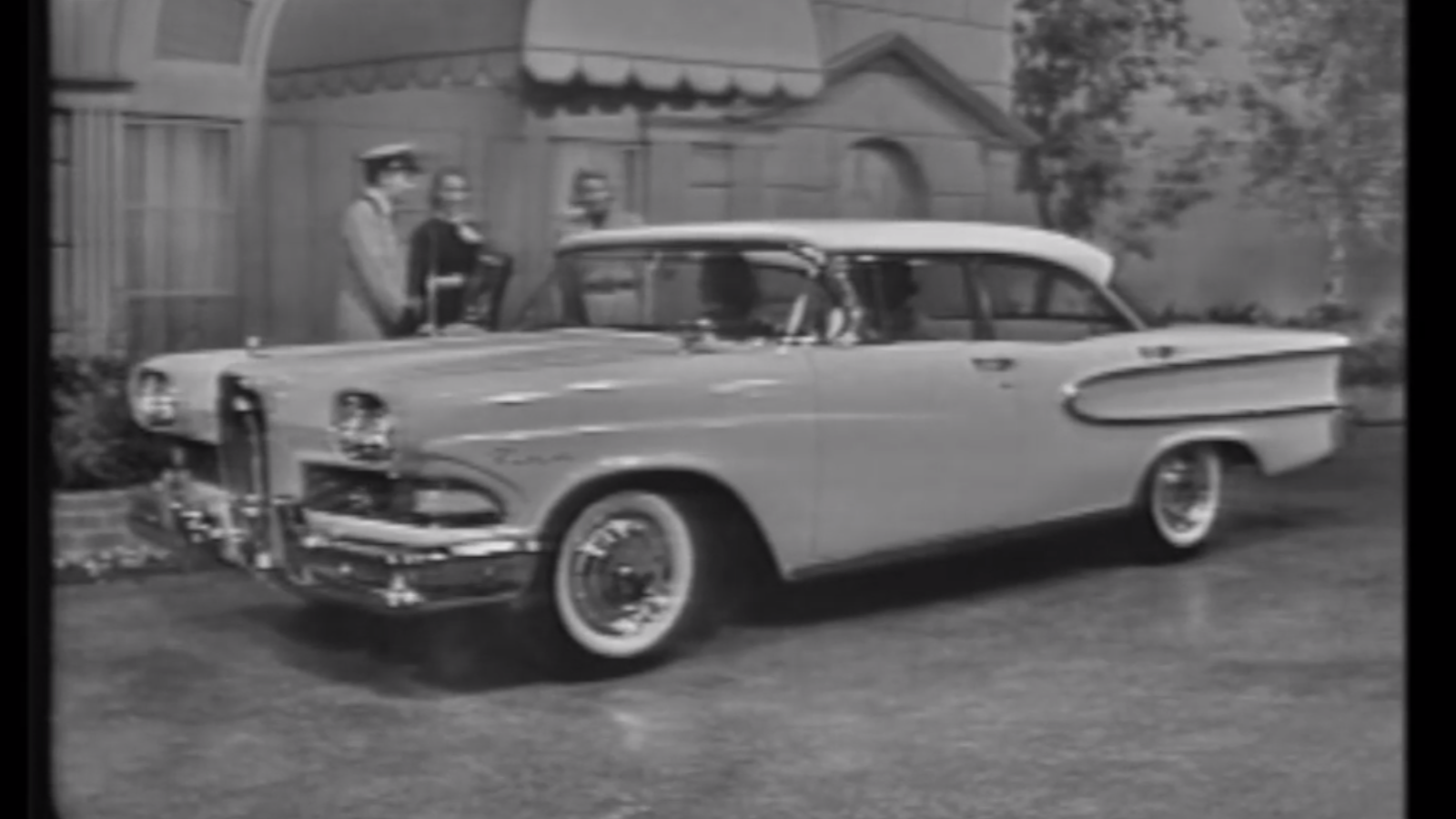


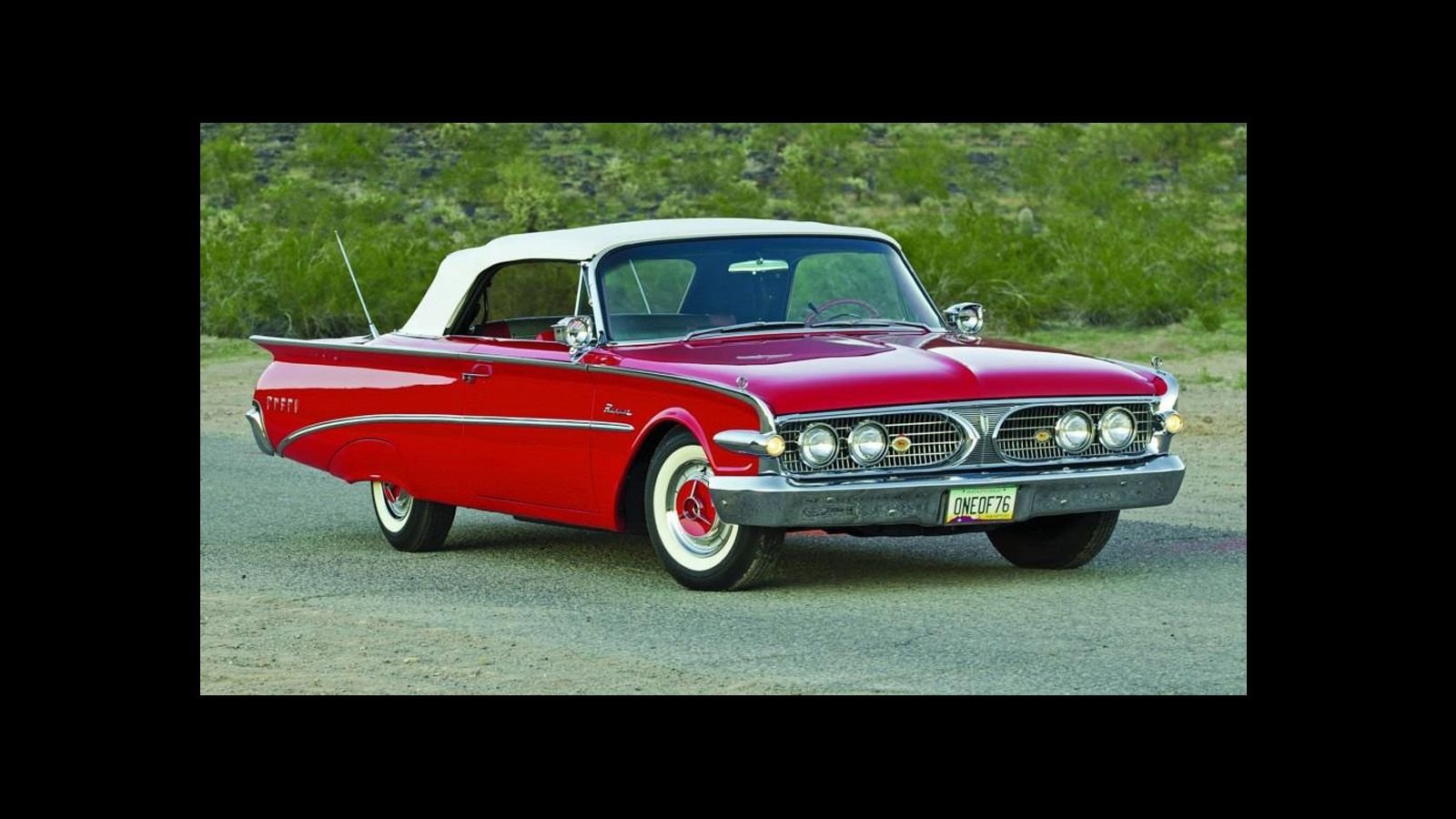


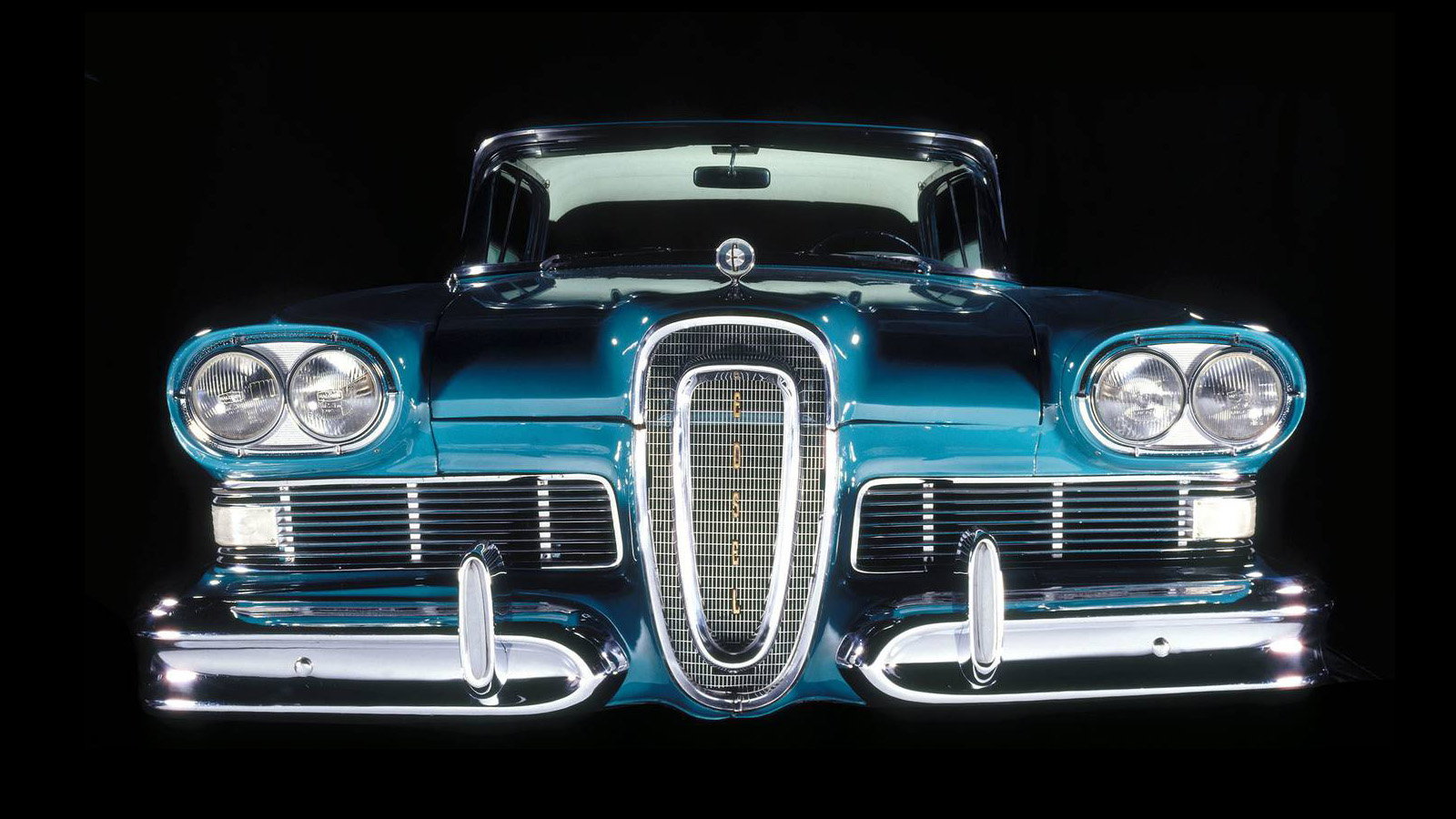













Failing to Succeed
“There's a silly notion that failure's not an option at NASA. Failure is an option here. If things are not failing, you are not innovating enough." -- Elon Musk
If you Google “failure quotes,” you will find more than 78 million results. That’s a lot of people talking about failure. Moreso, that’s a lot of people attempting to twist the concept of failure into something more positive. Failure is indeed a right of passage and you often can’t pass into anything good without failing at it several times.
The folks at Ford Motor Company know this first hand. The Ford Edsel is synonymous with the word failure. The road to the Edsel was paved in 1956 when the Ford Motor Company became a publically traded corporation, which meant that it was no longer controlled entirely by the Ford family. Several years earlier a group of Army Air Force veterans dubbed the “Whiz Kids” led by Charles B. “Tex” Thornton were brought in to form a planning department. Once Ford went public, Whiz Kids K. Edward Lundy and Robert S. McNamara gained more power and decided they would make manufacturing decisions based on market research and their allegedly sophisticated market analysis informed them that when it came to cars, consumers had no idea what they wanted. That’s when their “market research” evolved into “motivational research” and the Whiz Kids felt it was their obligation to talk a confused consumer market into things they didn’t know they wanted. Since Ford wanted to close the gap on market leaders GM and Chrysler, they decided to move Lincoln and Continental upmarket, and create a new premium mid-market vehicle to fill the void Lincoln left behind. They assured their investors that their new E Car (or Experimental Car) was a superior product that would be broadly accepted by the buying public.
A Lemon by any other name is still a Lemon
“Never confuse a single defeat with a final defeat.” -- F. Scott Fitzgerald
The naming of the Edsel was was just the beginning of its downfall. Edsel Ford was Henry Ford’s only son and was President and CEO of Ford Motor Company from 1919 until his death in 1943. Early on in the development of the E car, it was suggested that the car be named after Edsel, but Henry Ford II was opposed to the idea of his father’s good name “spinning around on thousands of hubcaps.” Ford then launched an extensive name search asking employees to participate, promising that the employee who chose the name would win a free E car. They even hired an advertising firm to assist in the name search. Eventually, they had a list of 6,000 names including early favorites such as Citation, Corsair, Pacer, and Ranger. All four of these names were eventually used for the vehicle’s series monikers. But the search didn’t end there. Desperate to find a name, Manager of Marketing Research, David Wallace, asked Pulitzer Prize-winning poet Marianne Moore for some suggestions. Moore came up with the strangest list of names imaginable, including Mongoose Civique, Dearborn Diamonte, Thunder Crestor, Pluma Piluma, Turcotinga, and Utopian Turtletop. Knowing that he’d be laughed out of the boardroom, Wallace didn’t share these entries with his superiors at Ford. With timing running out, number two man Ernest Breech, who was chairing a board meeting in the absence of Henry Ford II, decided that the E car would be called Edsel in honor of the son of Henry Ford.
This is the Edsel, never before a car like it
“Anyone who has never made a mistake has never tried anything new.” -- Albert Einstein.
Despite its bad rap and infamous standing in the history of the automotive industry, the Ford Edsel was not an awful car. For the 1958 model year, Ford offered four versions of the Edsel: If you needed a larger vehicle you could get the Mercury-based Edsel Citation or Corsair. If you preferred a smaller car, you could opt for the Ford-based Edsel Pacer or Ranger. The Citation alone came in two-door and four-door hardtop versions as well as a two-door convertible. The Corsair, Pacer, and Ranger also offered two- and four-door hardtop and convertible options. The larger Edsel Citation boasted an E475 V8 engine that offered 303 hp, 400 lbs of torque and could run 0-60 in 10.2 seconds. The brand also offered several features that were considered innovative -- such as its push button Teletouch transmission shifting system in the center of the steering wheel, a rolling-dome speedometer, warning lights for low oil level, engaged parking brake and overheating engine. Other innovations featured in the Edsel were ergonomically designed controls, self-adjusting brakes, seat belts and child-proof rear door locks.
They'll know you arrived when you drive up in an Edsel
“Failure is good as long as it doesn’t become a habit.” -- Michael Eisner
It’s important to keep in mind that post-Depression, post-war America was thriving during the mid-1950s. Life was good. New, wider, smoother highways were paved, exciting cars were all over the television sets, and slick, fashionable advertising “Mad Men” drove the world of commerce. It was a time of bleached white shirts with stiffly starched collars, Lucky Strikes, sexism, and three-martini lunches. The marketing executives of the time felt they knew more than the average consumer and took it upon themselves to help suggest what people needed to have.
The Whiz Kids at Ford had a marketing plan that was far bigger and more impressive than the Edsel itself: This year, a month ahead of all the other new cars, something really big was coming from Ford, something mysterious, a car unlike any other. The car of the future, the car that would change everything. They said so in the papers, the magazines, on TV, everywhere you looked. E-Day was coming and the Whiz Kids couldn’t contain their excitement because they just knew that the world was drooling in anticipation.
E Day
“Failures are finger posts on the road to achievement.” C.S. Lewis
E Day (September 4, 1957) marked the day that the Ford Motor Company would finally unveil the most mysterious, most anticipated car of all time: the Edsel. The hype was spectacular. Edsel ad man Fairfax Cone of the Foote, Cone & Belding agency created an unprecedented amount of excitement and anticipation. He put out two-page ads in Life magazine showing big automotive carriers carrying a load of wrapped, super-secret Edsels. But despite the heavy promotional blitz, customers were cool to its styling and conventional build. The Edsel was described as a "reborn LaSalle," a brand that went extinct in 1940. Evidence of Edsel’s lackluster reception could be found in a local paper in Ames, Iowa:
Heavy Turnout to see Edsels Ames (Iowa) Tribune, September 5, 1957, “A crowd estimated at some 10,000 people turned out Wednesday to view the unveiling of the completely new Edsel automobile at Larry Peterson Edsel Sales here... The viewers consumed 45 gallons of coffee and 54 dozen doughnuts during the day, Peterson said.”
The entire 1960 population of Ames, Iowa, was 27,003. Across America, 2.5 million Americans poured into Edsel showrooms on E-Day. What they saw was a bunch of ’58 Fords and Mercurys with horse-collar grilles, push-button transmissions, and weird speedometers. Millions looked, very few bought. It only took a few days for people to realize that E-Day was a clear catastrophe.
The Edsel Show
Tis a lesson you should heed:
Try, try, try again.
If at first you don't succeed,
Try, try, try again.
-- William Edward Hickson
About your car...
In her autobiography, Girl Singer (Doubleday, 1999), Rosemary Clooney recalled an incident during the telecast that perhaps foreordained the demise of the Edsel:
The show was built around the newest Ford offering, the 1958 Edsel. A new vista of motoring pleasure, unlike any other car you've ever seen. The only Edsel I ever saw was one they gave me to drive while I was rehearsing. I came out of the CBS Building, up those little steps to the street where my purple Edsel was waiting, like the Normandie in drydock. Mr. Ford was right behind me, heading for his Edsel. I opened the door of my car and the handle came off. I turned to him, holding it out to him. “About your car . . .”
To watch The Edsel Show, considered the oldest surviving videotape in existence, please click here.
The numbers don't lie
“Success is the ability to go from one failure to another with no loss of enthusiasm.” -- Winston Churchill
So what happened with the Edsel? Before explaining how a car that arrived with so much hype could so quickly blow away in the wind, we must look at the numbers. In its first year, Ford expected to sell over 200,000. When all was said and done, only 63,000 were sold. Over the years there has been a lot of research and debate over what went wrong. Today is universally accepted that several factors led to the quick death of the Edsel. First off, the Edsel hit the market during a recession. Debuting in one of the worst years since the Great Depression, the weak sales were reflected in other cars of the times: Mercury sales dropped 48%, Pontiac 28%, Dodge 47%, Oldsmobile 18%, and Buick 33%.
>>Join the conversation about the Edsel right here in the Ford Trucks Forum!
An Oldsmobile sucking a lemon
“I haven’t failed, I’ve just found 10,000 ways that won’t work.” -- Thomas A. Edison
So why were the numbers so low? When Ford was first conceptualizing the Edsel, post-war America was still thriving economically and American products were king. But by the late 50’s we had fallen into a recession. The desires of the public had shifted to smaller more economical cars for fuel efficiency. Assembly was also a problem. Because Edsel didn’t have its own designated factory, the larger Corsairs and Citations were assembled side by side with Mercuries in the Mercury factory while the smaller Pacers and Rangers were assembled in the Ford factory. Parts were often mixed up and some of the Edsels coming out of the factory were missing parts altogether. Some of these cars would show up at the dealership ill-equipped and in need of repair. Then there were the styling issues. The Edsel's most memorable design feature was its trademark "horsecollar" or "toilet seat" grille, which was quite distinct from other cars of the period. According to a popular joke at the time, the Edsel "resembled an Oldsmobile sucking a lemon," while automotive critic Neil Dan wrote that Edsel’s grille took on the appearance of a vagina. According to Edsel scholar Jan Deutsch, the Edsel was "the wrong car at the wrong time."
>>Join the conversation about the Edsel right here in the Ford Trucks Forum!
Knowing when to pull the plug
“There are no secrets to success. It is the the result of preparation, hard work, and learning from failure.” -- Colin Powell
Clearly, Ford knew when enough was enough. In 1959, they decided to discontinue the larger Mercury based Edsels and only released the Ranger and the Corsair. Only 44,900 were sold.
For the 1960 model year, only 2,846 Edsel vehicles were produced. Their fleet was limited to the Ranger series of sedans, hardtops, convertibles, and the Villager station wagons. The freestanding Edsel Division existed for marketing and sales but folded into Lincoln Mercury-Edsel-Lincoln when it became apparent it wasn’t selling.
>>Join the conversation about the Edsel right here in the Ford Trucks Forum!
Death of four wheels
“Even if you know what’s coming, you are never prepared for how it feels.” -- Natalie Standiford
On November 19, 1959, Ford announced the end of the Edsel program. The company lost $400 million, or the equivalent of close to $4 billion in 2017 dollars. Only 118,287 Edsels were built, including 7,440 produced in Ontario, Canada. By U.S. auto industry standards, these production figures were dismal, particularly when spread across a run of three model years.
It was an expensive lesson to learn. But the lessons were right there in front of them, starting with the failure to understand the American consumers. Scholars on the subject also pointed to weak internal support within Ford’s executive offices. Marketers learned how NOT to market a product.
What became apparent was that Ford never “test marketed” the vehicle or its unique styling concepts with potential “real” buyers prior to either the vehicle’s initial development decision or the vehicle’s shipments to its new dealerships. Edsels were shipped to the dealerships undercover and remained wrapped on the dealer lots. Model for model, buyers did not understand what the car was supposed to be—a step above the Mercury, or a step below it.
A light at the end of the rainbow
“I've missed more than 9,000 shots in my career. I've lost almost 300 games. Twenty-six times I've been trusted to take the game-winning shot and missed. I've failed over and over and over again in my life. And that is why I succeed.” -- Michael Jordan
By 1958, buyers had become fascinated with economy cars, and a large car like the Edsel was seen as too expensive to buy and own. When Ford introduced the Falcon in 1960, it sold over 400,000 units in its first year. Ford's investment in expanded plant capacity and additional tooling for the Edsel helped make the company's subsequent success with the Falcon possible.
Moreso, the scheduled 1960 Edsel Comet compact car was hastily rebranded as the Comet and assigned to Lincoln-Mercury dealerships as a stand-alone product. Based on the new-for-1960 Ford Falcon, the Comet was an immediate success, selling more cars in its first year than all models of Edsel produced during that marque's entire three-year run.
>>Join the conversation about the Edsel right here in the Ford Trucks Forum!
Long Live the Edsel
More than half a century has passed since Edsel’s spectacular failure, but the car lives on not only infamously but also as a much sought-after collectible among vintage car hobbyists. Fewer than 10,000 Edsels survive and they are considered valuable collectors’ items. A mint-condition Edsel convertible from any of its three model years may sell for over $100,000. The rarest Edsel is the 1960 Ranger convertible. Only 76 were built, and approximately 25 survive today.
While Edsel's front end design was considered "weird" or "too different" by contemporary buyers and critics, many other car manufacturers (such as Pontiac, Jaguar, BMW, Subaru, Lancia, Alfa Romeo, and Saab) have employed similar vertical grilles successfully in their car designs. Many of Edsel's features, such as self-adjusting brakes, gear selection by steering wheel buttons, etc., which were considered "too impractical" in the late 1950s, are now standard features of sports cars.
There is a lot to be learned from the rise and fall of the Ford Edsel; however, the point of its short life can be summed up by perhaps the most successful automobile designer and manufacturer of all time:
“Failure is simply the opportunity to begin again, this time more intelligently.” -- Henry Ford, Founder of Ford Motor Company, Father of Edsel.
>>Join the conversation about the Edsel right here in the Ford Trucks Forum!
For help with service of your truck, check out the how to section of Ford-Trucks.com
